News
Which Statement is True About Blockchain?
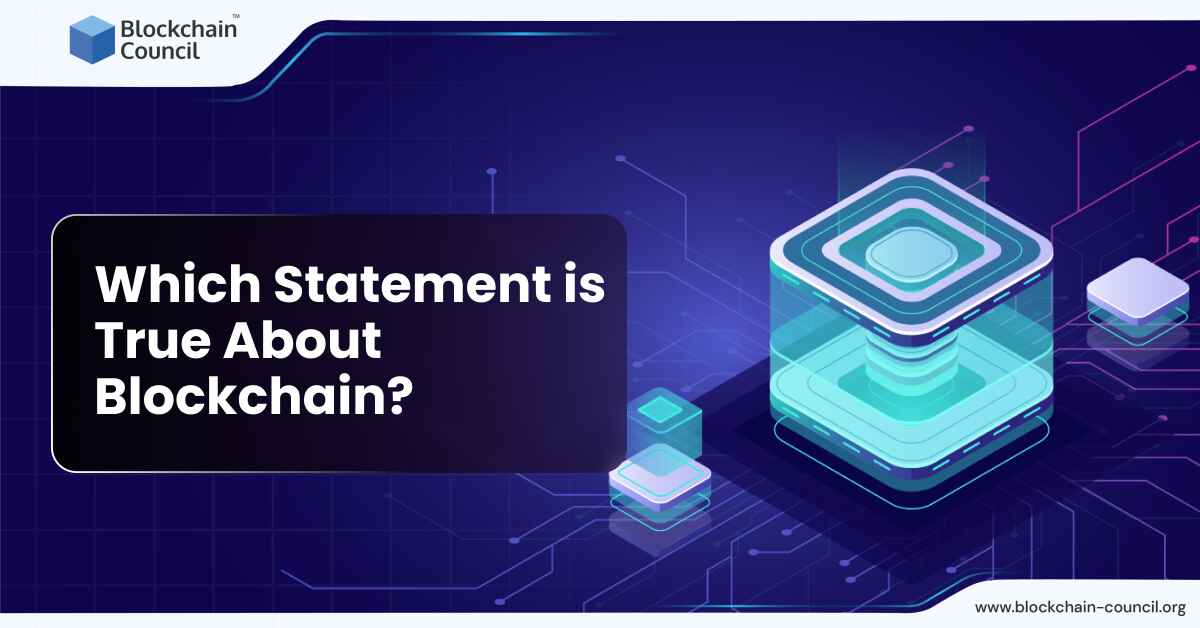
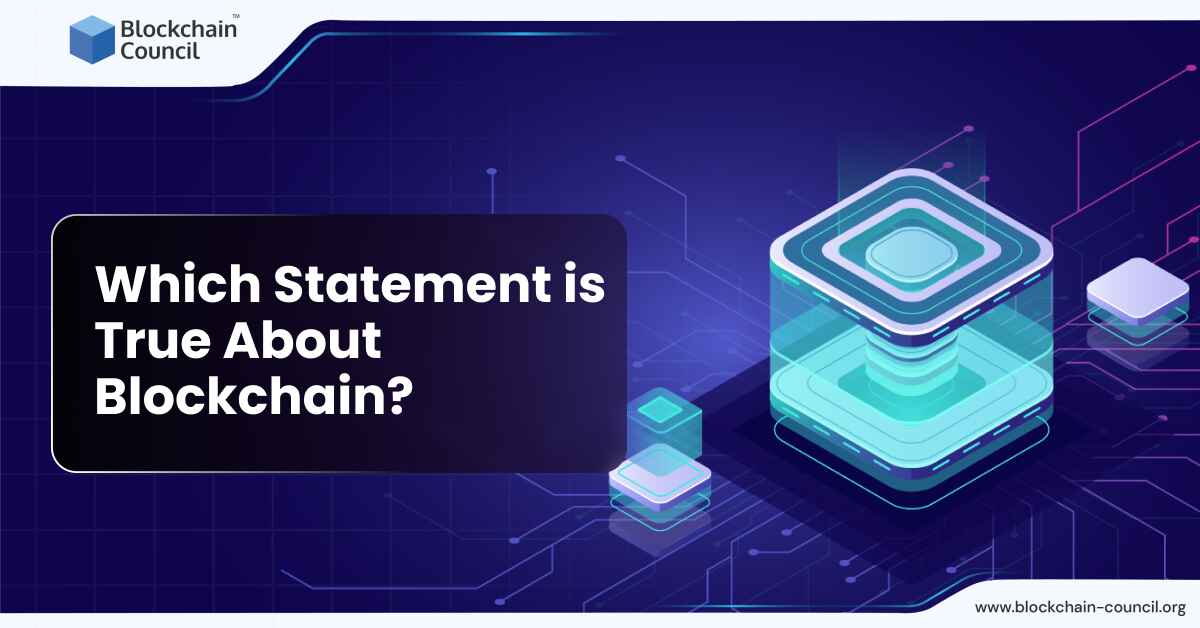
-
Blockchain Council
-
July 06, 2024
Blockchain has been a hot topic for a while, sparking conversations and debates worldwide. It’s everywhere, from financial news to tech forums. But with all the buzz, it can be tricky to figure out what’s true and what’s not. Is it just for Bitcoin? Can it really change the way we handle data?
Let’s understand which of the following statements are true about Blockchain and why!
Which Statement is True About Blockchain?
1. Blockchain technology is only used for cryptocurrency transactions.
False. While Blockchain technology gained popularity through cryptocurrencies like Bitcoin, it has many other applications. Blockchain enhances transparency and security in various industries such as finance, supply chain management, healthcare, real estate, and more. For example, it helps track and verify products in supply chains, manage medical records securely, and streamline real estate transactions.
2. Blockchain transactions can be easily altered once recorded.
False. One of the main features of Blockchain is its immutability. Once a transaction is recorded on the Blockchain, it cannot be easily altered or deleted. This ensures data integrity and security, making Blockchain a reliable solution for recording and verifying transactions.
3. Blockchain can only operate in a decentralized manner.
False. While decentralization is a key feature of many Blockchain implementations, it is not a strict requirement. Some Blockchain networks operate in a more centralized manner, where a single or limited number of entities control the network. These are often referred to as private or permissioned Blockchains, used by organizations for specific applications like supply chain management or interbank settlements.
4. All Blockchain technologies require extensive energy consumption.
False. The energy consumption of Blockchain technologies varies. Cryptocurrencies like Bitcoin, which use Proof of Work (PoW) consensus algorithms, are known for their high energy usage. However, other Blockchain systems use more energy-efficient consensus mechanisms, such as Proof of Stake (PoS) or Practical Byzantine Fault Tolerance (PBFT), which significantly reduce energy consumption. For example, Ethereum’s transition from PoW to PoS has drastically reduced its energy consumption by over 99%.
5. Blockchain applications are currently widespread in mainstream industries.
True. Blockchain applications have expanded into many mainstream industries. In finance, it is used for secure payments and digital identity verification. The supply chain sector benefits from Blockchain for tracking products and ensuring authenticity. Healthcare uses Blockchain for secure patient data management, and real estate leverages it for transparent property transactions. These examples demonstrate Blockchain’s broad applicability beyond just cryptocurrencies.
6. Blockchain technology can enhance the transparency and efficiency of supply chains.
True. Blockchain technology offers significant benefits for supply chain management. It creates an immutable ledger that records every transaction and movement of goods, ensuring data accuracy and security. This allows stakeholders to verify and audit the supply chain in real-time. For example, Walmart uses Blockchain to track the movement of leafy greens, ensuring product safety and traceability. Blockchain helps improve transparency, reduce fraud, and streamline various processes like procurement and payments.
7. Blockchain transactions can be easily reversed or altered once they have been added to the ledger.
False. One of the core features of Blockchain technology is its immutability. Once a transaction is recorded on the Blockchain, it cannot be easily altered or deleted. This ensures the integrity and security of the data, making Blockchain a reliable system for recording transactions. The immutable nature of Blockchain prevents unauthorized changes and tampering.
8. Artificial intelligence can be integrated with Blockchain to improve supply chain management by automating data analysis and optimizing processes.
True. Integrating artificial intelligence (AI) with Blockchain can significantly enhance supply chain management. AI can analyze large volumes of data to optimize processes, predict risks, and improve decision-making. Combined with Blockchain’s transparency and data integrity, AI can automate and streamline supply chain operations, making them more efficient and reliable. For instance, AI can use Blockchain data to optimize inventory management and predict supply chain disruptions.
9. Blockchain applications are expanding into areas beyond cryptocurrencies, such as healthcare and identity verification.
True. Blockchain technology is being used in various sectors beyond cryptocurrencies. In healthcare, Blockchain secures patient data and streamlines the sharing of medical records. For identity verification, Blockchain provides secure and tamper-proof solutions. Other industries, such as real estate, voting systems, and supply chain management, also benefit from Blockchain’s capabilities in enhancing transparency, security, and efficiency.
10. Blockchain technology is only used for financial transactions and has no other practical applications.
False. While Blockchain is well-known for its role in financial transactions and cryptocurrencies, it has numerous other applications. Blockchain enhances transparency and efficiency in supply chains, secures patient data in healthcare, verifies product authenticity in retail, and provides tamper-proof voting systems. These diverse applications show that Blockchain technology has practical uses across many industries, not just finance.
11. Blockchain technology is only used for financial transactions and has no other practical applications.
False. Blockchain technology extends far beyond financial transactions. It enhances transparency and security in supply chains, secures patient data in healthcare, and verifies identities. In real estate, Blockchain streamlines property transactions, and in retail, it helps authenticate products. These diverse applications highlight Blockchain’s versatility across various industries, not just finance.
12. Private Blockchain networks can improve the security of sensitive data but often lack interoperability with other Blockchains.
True. Private Blockchains enhance data security by restricting access to authorized participants. However, they often face interoperability challenges, making it difficult to integrate with other Blockchain networks. This limitation can hinder the seamless exchange of information between different Blockchain systems.
13. All Blockchain platforms are public and allow anyone to participate without restrictions.
False. Not all Blockchain platforms are public. While public Blockchains like Bitcoin and Ethereum allow open participation, private Blockchains restrict access to authorized users. Additionally, consortium Blockchains involve a group of organizations managing the network together, blending aspects of both public and private Blockchains.
14. Hybrid Blockchains combine elements of both private and public Blockchains, offering both security and transparency where needed.
True. Hybrid Blockchains merge features of both private and public Blockchains. They provide controlled access to sensitive data while maintaining transparency for other information. This combination ensures security and flexibility, making hybrid Blockchains suitable for various applications, such as finance and supply chain management.
15. Consortium Blockchains are ideal for industry groups that need to share data securely among members.
True. Consortium Blockchains, also known as federated Blockchains, are managed by a group of organizations. They balance centralized control with decentralized principles, making them perfect for industry groups that need to share data securely among members. Examples include R3’s Corda, used by financial institutions for secure transactions and data sharing.
Blockchain technology inherently requires significant energy consumption, regardless of the consensus mechanism used.
16. Blockchain as a service (BaaS) is emerging as a significant trend, enabling more companies to utilize Blockchain technology without extensive infrastructure.
True. Blockchain as a Service (BaaS) is gaining traction, allowing businesses to adopt Blockchain technology without the need for extensive infrastructure investments. BaaS providers offer platforms that handle the setup, maintenance, and security of Blockchain networks, enabling companies to focus on their core operations while leveraging Blockchain’s benefits. This trend makes Blockchain accessible to a wider range of organizations, from startups to large enterprises
17. Smart contracts on Blockchain can automate and secure contract fulfillment, reducing the need for manual oversight.
True. Smart contracts are self-executing contracts with the terms directly written into code. They automatically enforce and execute the contract when predefined conditions are met, reducing the need for intermediaries and manual oversight. This ensures security and transparency, as all actions are recorded on the Blockchain. Industries like finance, real estate, and supply chain management are leveraging smart contracts to streamline operations and reduce costs.
18. Blockchain technology is fully mature and no longer faces significant developmental challenges.
False. While Blockchain has made significant advancements, it still faces developmental challenges. Scalability, interoperability, and regulatory issues are ongoing concerns. Additionally, the integration of new technologies like quantum computing and improvements in energy efficiency are areas of active research and development.
19. In the telecommunications industry, Blockchain is being used to manage mobile roaming transactions and billing.
True. Blockchain is being utilized in telecommunications to enhance the efficiency and transparency of mobile roaming and billing. It enables secure and automated processing of roaming agreements, reducing fraud and operational costs. By using a decentralized ledger, telecom companies can ensure accurate and tamper-proof records of all transactions.
20. Blockchain networks do not provide any means to track the origin or history of transactions.
False. Blockchain inherently provides a transparent and immutable record of all transactions. Each transaction is recorded in a block that is linked to previous blocks, forming a chain. This allows anyone to trace the origin and history of transactions back to their source. This transparency is one of Blockchain’s key features, making it valuable for applications requiring auditability and trust, such as supply chain management and financial transactions.
21. Blockchain can help reduce identity theft by securely storing personal identity information on a decentralized network.
True. Blockchain technology enhances identity security by storing personal information on a decentralized network. This makes it difficult for hackers to access and alter data. Decentralized Identifiers (DIDs) and Verifiable Credentials (VCs) ensure secure and tamper-proof identity verification, giving individuals control over their personal information. This reduces the risk of identity theft and fraud, as only the individual can grant access to their data. Moreover, self-sovereign identity (SSI) frameworks built on Blockchain allow individuals to control and manage their personal information securely, preventing unauthorized access and reducing the risk of identity theft.
22. Private Blockchains provide transparency and are accessible by anyone on the internet.
False. Private Blockchains restrict access to authorized participants only. They enhance privacy and control over data, but they do not provide the same level of transparency as public Blockchains. Only selected members can view and validate transactions, making them suitable for internal business processes rather than open, public access.
23. The integration of Blockchain and IoT can bolster security against hacking and unauthorized data access.
True. Combining Blockchain with the Internet of Things (IoT) enhances security by creating a tamper-proof ledger for IoT devices. Blockchain can securely record and verify the data generated by these devices, reducing the risk of hacking and unauthorized access. This integration ensures that data integrity is maintained across the network, making IoT systems more resilient to attacks.
24. Blockchain can be used to ensure the authenticity and integrity of digital content, including preventing the spread of deep fakes.
True. Blockchain technology can verify the authenticity and integrity of digital content by creating a transparent and immutable record of its creation and modifications. This helps in tracking the origin and history of digital files, making it difficult to alter them without detection. For instance, Blockchain can be used to certify the authenticity of videos, images, and documents, thus helping to combat the spread of deep fakes and other fraudulent content.
25. Blockchain has reached its peak in innovation and no longer drives new technological advancements.
False. Blockchain technology continues to evolve and drive new technological advancements. Innovations such as layer 2 solutions, which reduce energy consumption, the integration of quantum computing, and integration with AI and IoT for enhanced security and efficiency, are just a few examples. Blockchain applications in various sectors, including finance, supply chain, healthcare, and digital identity, are continuously expanding, showing that the technology still has significant room for growth and development.
Conclusion
Throughout this discussion, we’ve tackled some key truths and debunked popular myths surrounding Blockchain technology. The journey through understanding which statement is true about Blockchain shows us that it is much more than just a platform for cryptocurrency transactions. As we’ve seen, it goes beyond cryptocurrencies, offering new possibilities in various fields. Understanding the basics helps us see its potential and future impact. As Blockchain continues to grow, staying informed about its true capabilities and uses is crucial for anyone curious about technology’s future.
News
Blockchain Technology Will Transform Water Access and Management Globally

Disclosure: The views and opinions expressed here are solely those of the author and do not represent the views and opinions of the crypto.news editorial team.
Access to clean water is a basic human need, yet billions of people around the world still struggle to get it. According to the World Health Organization, over 2 billion people live in countries suffering from severe water stress, and this number is expected to continue to grow due to climate change and population growth.
Traditional water management systems have struggled to address these challenges, often hampered by inefficiencies, lack of transparency, and misallocation of resources. Blockchain technology offers a promising solution to these challenges, providing equitable access and sustainable use of this crucial resource.
The current state of water management
Water management today faces several pressing issues. Inefficiencies in water supply, distribution, and use, coupled with a lack of real-time monitoring, often result in resource waste and misallocation. Many water sources fail to realize their full potential due to infrastructure and financing shortfalls. For example, the Environmental Protection Agency (EPA) report indicated that the United States would need to invest $625 billion over the next 20 years to repair, maintain and improve the country’s drinking water infrastructure due to aging pipes and other infrastructure problems. Additionally, in the United States alone, household leaks can to waste nearly 900 billion gallons of water per year nationwide. This is equivalent to the annual domestic water consumption of nearly 11 million homes.
Furthermore, corruption and mismanagement of water resources can cause unequal distribution, with disadvantaged communities often bearing the brunt of water scarcity. For example, South Africa is struggling with myriad challenges to its water security: drought, inadequate water conservation measures, outdated infrastructure, and unequal access to water resources. The country faces significant water scarcity, with demand expected to outstrip supply by 2030, creating a projected gap of 17%.
Furthermore, the global water industry is highly monopolized, with a few key players controlling a significant share of the market. These companies exert substantial influence over the water supply chain, often prioritizing profit over equitable distribution and environmental responsibility. This concentration of power can lead to inflated prices and limited access for vulnerable populations. The global bottled water market alone is projected to reach $509.18 billion by 2030, with these large companies capturing a significant share of revenue. This monopolization exacerbates existing inequalities in water access and highlights the need for more decentralized and community-driven water management solutions.
Source: Grand View Search
The potential of blockchain in water management
Blockchain technology can address these issues by providing a transparent, secure, and decentralized platform for water resource management. This approach offers several advantages:
- Transparency and accountability. Blockchain’s immutable ledger ensures that all transactions and data entries are transparent and cannot be changed once recorded. This transparency can reduce corruption and ensure that water resources are allocated fairly and efficiently. For example, blockchain can be used to track water usage from source to end user, providing a clear record of how water is distributed and used. This level of transparency can help hold authorities accountable and manage water resources sustainably.
- Efficient resource management. Blockchain can facilitate the creation of smart contracts, which are self-executing contracts with the terms of the agreement written directly into the code. These contracts can automate water distribution based on real-time data, directing water to where it is needed most. For example, smart contracts could be used to manage urban water supply systems, automatically adjusting water distribution based on real-time consumption patterns and demand. This can help optimize water use, reduce waste, and ensure that households and businesses receive the right amount of water at the right time.
In Dubai, the Dubai Electricity and Water Authority (DEWA) has implemented a blockchain-based smart water network initiative as part of its broader smart city strategy. This project integrates blockchain technology with IoT sensors to monitor water usage in real time, manage distribution, and detect leaks. The decentralized ledger ensures data integrity and transparency, enabling more efficient water management and reduced waste. DEWA’s initiative aims to improve sustainability and resource management in the rapidly growing city, highlighting the potential of blockchain to support urban water management and conservation efforts.
Community participation and ownership
Through blockchain, individuals can directly control and monetize their access to water resources, eliminating the need for third-party intermediaries. This direct control model allows local communities to make collective and transparent decisions about their water use. By managing their water directly from the source, communities can tailor water management practices to their specific needs, promoting equitable distribution and encouraging a sense of accountability and stewardship.
Additionally, future models could allow people to monetize their access to water through web3 technologies. For example, a community-to-business (C2B) model could allow people to sell water directly to companies. In this model, people do not have to own the water directly, but can profit by staking their tokens during event sales pools. This approach not only supports sustainable water management, but also creates economic opportunities for community members. Additionally, a “Burn to Secure” protocol can be used to provide water allocation rights. This protocol provides a true sense of water security and financial opportunity by allowing people to redeem their rights. This system not only secures future water allocations, but also increases token scarcity and value.
Additionally, a pure sense of investment is achieved through investments in water sources. This leads to potential financial returns and dividends by addressing the inefficiencies in water supply mentioned above. By investing to finance infrastructure projects, such as building factories and improving distribution systems, more water can be brought to communities, creating additional economic opportunities.
Monetizing water access through the C2B model, the “Burn to Secure” protocol, and investments in water sources all generate economic benefits for the community, promoting a more equitable and efficient water management system.
Overcoming challenges
While blockchain technology has the potential to improve water management, there are challenges to its adoption. The complexity of blockchain systems and the need for technological infrastructure can be barriers, especially in developing regions. Additionally, there are concerns about the significant energy consumption of blockchain networks. However, technological advances and the development of more energy-efficient blockchain solutions are helping to alleviate these concerns. Additionally, education and capacity building are key to ensuring stakeholders understand how to effectively use blockchain technology. Governments, NGOs, and private sector partners need to work together to provide training and support to communities and water management authorities.
Blockchain technology offers a practical and effective means to improve water management. In addition to addressing inefficiencies, blockchain empowers communities, promotes sustainable practices, and opens up new economic opportunities through models like community-to-business (C2B). As we face the growing challenges of climate change and population growth, blockchain is not only an innovative solution, but represents a fundamental shift in the way we manage and value water resources. Adopting blockchain in water management is essential to creating a sustainable and equitable future by changing the way we interact with and protect our most vital resource.

Jean-Hugues Gavarini
Jean-Hugues Gavarini is the CEO and co-founder of LAKE (LAK3), a real-world asset company leveraging blockchain technology to decentralize access to the global water economy. LAKE aims to ensure access to clean water for all, protect water resources, and deliver water to those in need through innovative technologies. Jean-Hugues has a diverse career spanning the luxury, fashion, and footwear industries. His career path includes notable successes at Mellow Yellow, Cremieux, and Tod’s. Raised between Silicon Valley and the French Alps, Jean-Hugues has always been immersed in technology and freshwater resources. In 2018, Jean became the CEO of Lanikea Waters, a water solutions entity based in the French Alps. In 2019, the concept of LAKE was born, embodying his commitment to innovation and sustainability.
News
Blockchain and AI Expo 2024
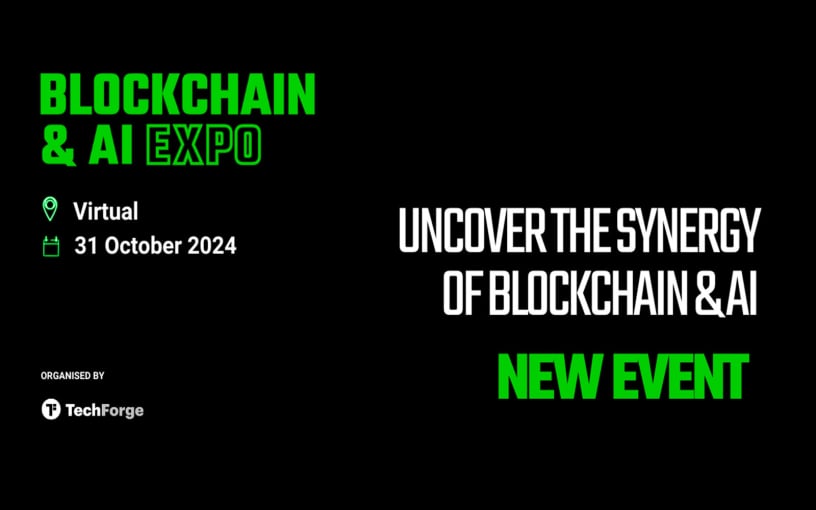
With rapid advances in the world of AI and blockchain, there are opportunities to leverage the security and transparency features of blockchain to improve the reliability and trust of AI systems and data transactions.
Explore the synergy of these advanced technologies in virtual mode Blockchain and AI Expowhich takes place on October 31, 2024 TO 10:00 GMT.
The event features cutting-edge presentations led by leading experts in evolving fields. Presentations are set to explore opportunities and challenges in the fusion of blockchain and AI, real-world applications, ethics, innovations in environmental sustainability, and more!
Gain a comprehensive understanding of how these technologies can synergistically drive innovation, optimize operations, and promote strategic growth opportunities. Develop your knowledge to facilitate informed decision making and give your company a competitive edge in the growing technology landscape.
News
Nigeria Eyes National Blockchain Nigerium for Data Sovereignty

Nigeria is keeping an eye on a new native blockchain network to protect the country’s data sovereignty.
According to local media, a team from the University of Hertfordshire has proposed the new blockchain, Nigeriato the National Information Technology Development Agency (NITDA).
Chanu Kuppuswamy, who leads the team, argued that relying on blockchain networks whose developers are located in other regions poses national security risks to the Nigerian government. He further said that Nigerium would allow the West African nation to customize the network to meet specific needs, while also promoting data sovereignty.
In his presentation, Chanu cited the recent migration of Ethereum to test of participation (PoS) consensus as an instance in which no Nigerians were involved but whose impact is far-reaching.
“Developing an indigenous blockchain like Nigerium is a significant step towards achieving data sovereignty and promoting trust in digital transactions in Nigeria,” he said.
While receiving the proposals in Abuja, NITDA’s Kashifu Abdullahi acknowledged the benefits a local blockchain would bring to Nigeria, including increased security of citizens’ data.
However, a NITDA spokesperson later clarified that Nigerium is still at the proposal stage and that the government has not yet decided whether to proceed or not.
“The committee is still discussing the possibility with stakeholders. Even if a decision is finally made, there is no guarantee that the name will be Nigerium,” the spokesperson told the media.
Nigerium’s reception in the country has been mixed. Some, like financial analyst Olumide Adesina, To say the network is “dead on arrival”. He believes the Nigerian government’s poor record in following through on its big technology plans will claim another victim. He pointed to the eNaira as a missed opportunity whose chances of success were much higher than those of Nigerium.
Others welcomed the proposal. Chimezie Chuta, who chairs the renewed The Nigerian Blockchain Policy Committee is “extremely optimistic“that Nigerium will be more successful than eNaira.
Speaking to a local news agency, Chuta stressed that eNaira failed because the central bank initiated the project on its own, without involving any stakeholders.
“They just cooked it and expected everyone to like it. [With Nigerium]there will be a lot of collaboration,” he said.
Registration of property title, digital identity and Certificate Verification are among the use cases that Nigerium is expected to initially target. However, Nigeria has already made progress in some of these fields through public blockchains.
SPPG, a leading school in governance and politics, announced in May the country’s first blockchain certificate verification system. Built on the The BSV BlockchainIt was developed in collaboration with the blockchain data recording company VX Technologies and local lender Sterling Bank.
Watch: The Future Has Already Arrived in Nigeria
 Italian: https://www.youtube.com/watch?v=M40GXUUauLU width=”560″ height=”315″ frameborder=”0″ allowfullscreen=”allowfullscreen”>
Italian: https://www.youtube.com/watch?v=M40GXUUauLU width=”560″ height=”315″ frameborder=”0″ allowfullscreen=”allowfullscreen”>
New to blockchain? Check out CoinGeek Blockchain for Beginners section, the definitive guide to learn more about blockchain technology.
News
Cambodian CBDC Developer to Build Palau Bond Market on Blockchain: Report
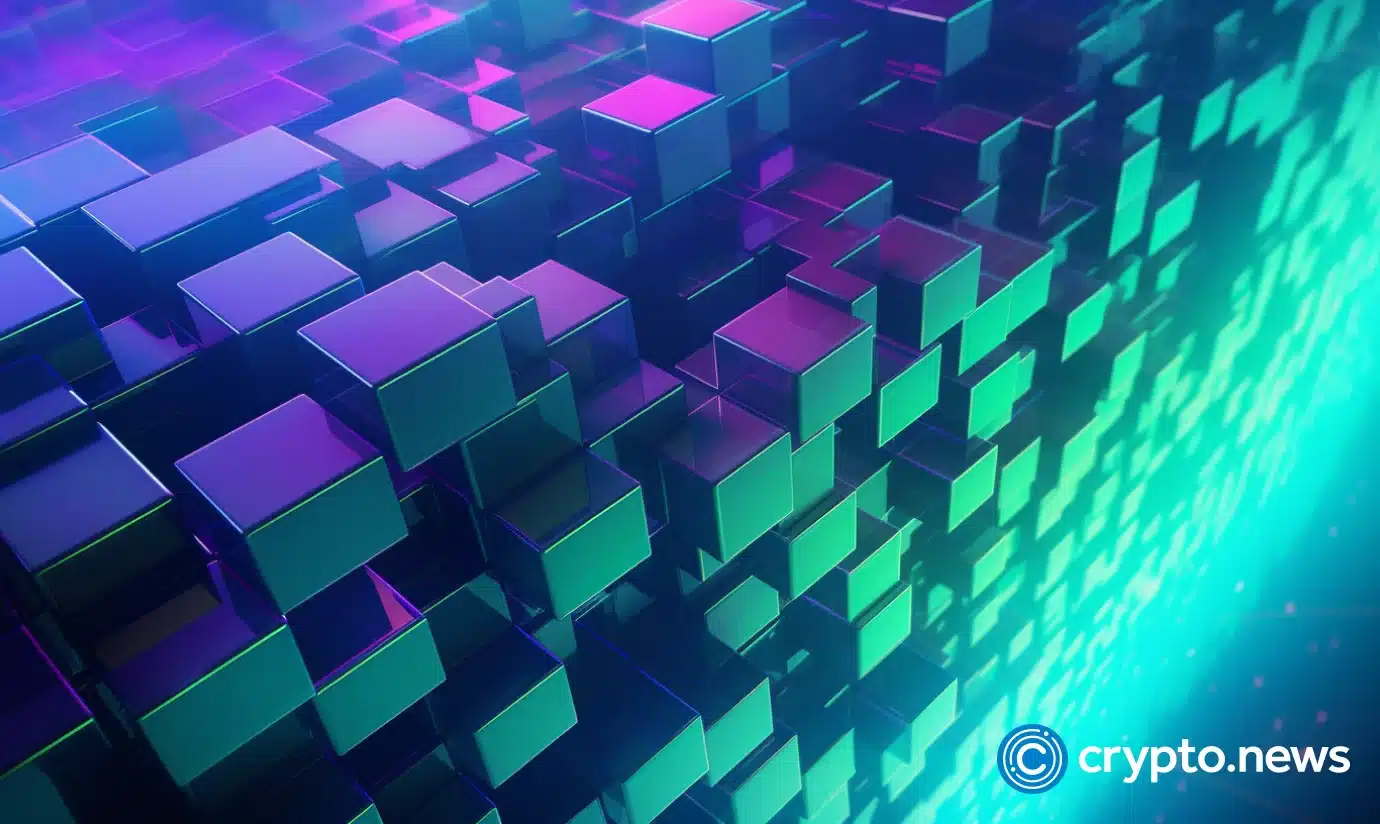
A Japanese fintech developer will build a blockchain-based bond market gateway for Palau, aiming to launch a trial in 2024 and a full launch the following year.
Japanese fintech developer Suramitsubest known for developing a central bank digital currency (CBDC) for Cambodia, is intended to build a Blockchain-gateway to the bond market based on the Pacific island nation of Palau, Nikkei He learned.
Soramitsu won the contract and plans to introduce the market on a trial basis in fiscal 2024, with a full launch scheduled for the following year, allowing the Palauan government to issue bonds to individual investors and efficiently manage principal and interest payments, according to the report.
The total cost of the project is estimated at several hundred million yen ($1.2 million to $5.6 million), less than half the cost of a non-blockchain alternative, people familiar with the matter said. The project has reportedly received support from Japan’s Ministry of Economy, Trade and Industry, with Japan’s foreign and finance ministries providing strategic and management advice on the project.
Soramitsu’s successful development of Cambodia’s CBDC in 2020 has boosted its reputation, with the digital currency’s popularity soaring, with over 10 million accounts opened by December 2023, representing 60% of Cambodia’s population. Following this, Cambodia’s central bank governor Chea Serey indicated intends to expand the reach of its CBDC internationally, particularly through collaboration with UnionPay International, the Chinese card payment service, and other global partners.
While Soramitsu’s work in Cambodia has been well received, the long-term popularity of CBDCs remains to be seen. As of late June, crypto.news reported a sharp drop in activity in India’s digital currency, the e-rupee, after local banks stopped artificially inflating its values.
According to people familiar with the matter, the Reserve Bank of India managed to hit the 1 million retail transaction milestone last December only after the metrics were artificially infiltrated by local banks, which offered incentives to retail users and paid a portion of the bank’s employees’ salaries using the digital currency.
-

 News1 year ago
News1 year ago“Captain Tsubasa – RIVALS” launches on Oasys Blockchain
-

 Ethereum1 year ago
Ethereum1 year agoComment deux frères auraient dérobé 25 millions de dollars lors d’un braquage d’Ethereum de 12 secondes • The Register
-

 News1 year ago
News1 year agoSolana ranks the fastest blockchain in the world, surpassing Ethereum, Polygon ⋆ ZyCrypto
-

 Videos1 year ago
Videos1 year agoHistoric steps for US cryptocurrencies! With a shocking majority vote!🚨
-

 Videos1 year ago
Videos1 year agoIs Emorya the next gem💎 of this Bitcoin bull run?
-

 News1 year ago
News1 year agoSolana Surpasses Ethereum and Polygon as the Fastest Blockchain ⋆ ZyCrypto
-

 Videos1 year ago
Videos1 year agoNexus Chain – Ethereum L2 with the GREATEST Potential?
-

 Ethereum1 year ago
Ethereum1 year agoScaling Ethereum with L2s damaged its Tokenomics. Is it possible to repair it?
-

 News1 year ago
News1 year agoFnality, HQLAᵡ aims to launch blockchain intraday repositories this year – Ledger Insights
-
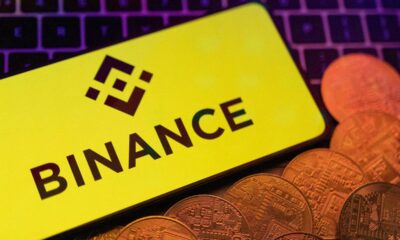
 Regulation1 year ago
Regulation1 year agoFinancial Intelligence Unit imposes ₹18.82 crore fine on cryptocurrency exchange Binance for violating anti-money laundering norms
-

 Bitcoin1 year ago
Bitcoin1 year agoBitcoin Drops to $60K, Threatening to Derail Prices of Ether, Solana, XRP, Dogecoin, and Shiba Inu ⋆ ZyCrypto
-

 News1 year ago
News1 year agoSendBlocks Debuts with Major Support to Improve Blockchain Data Management











